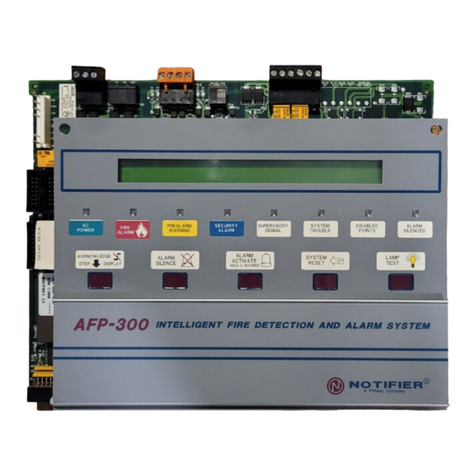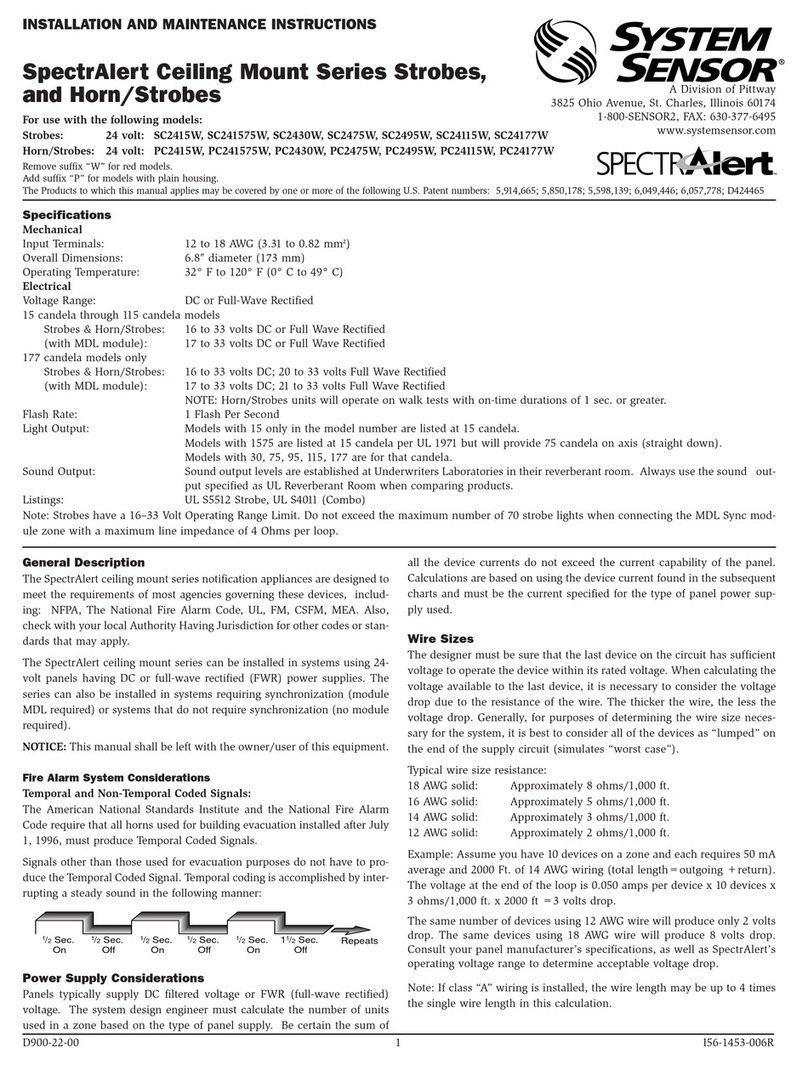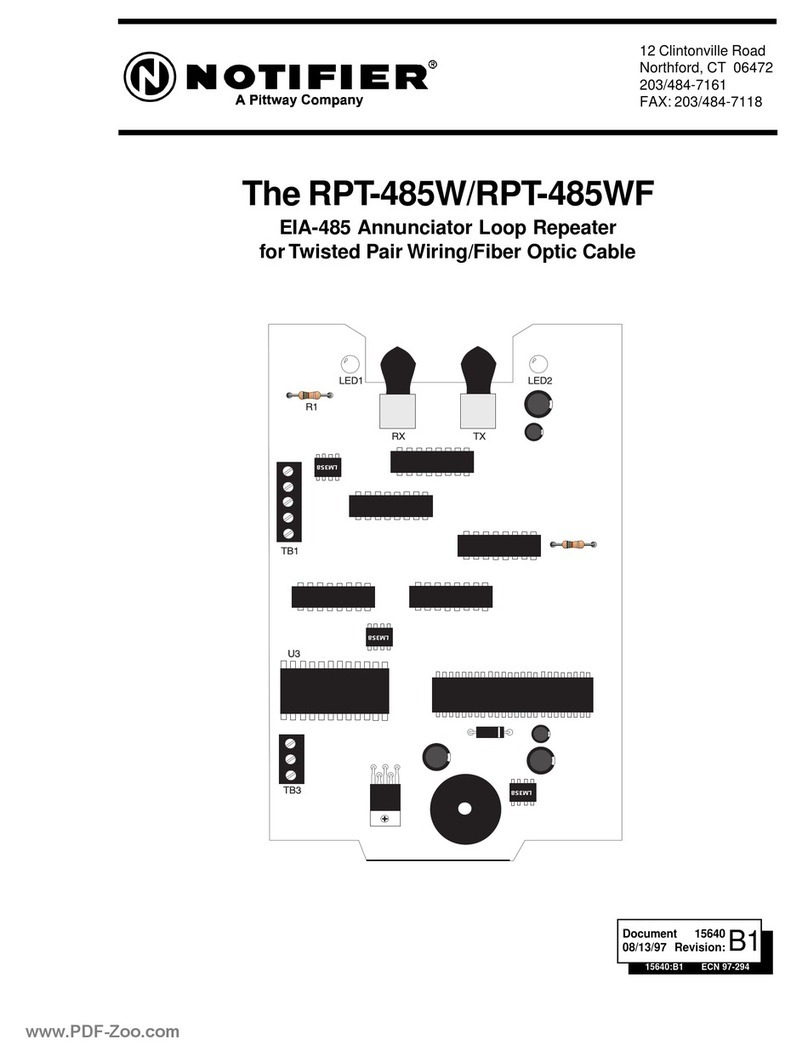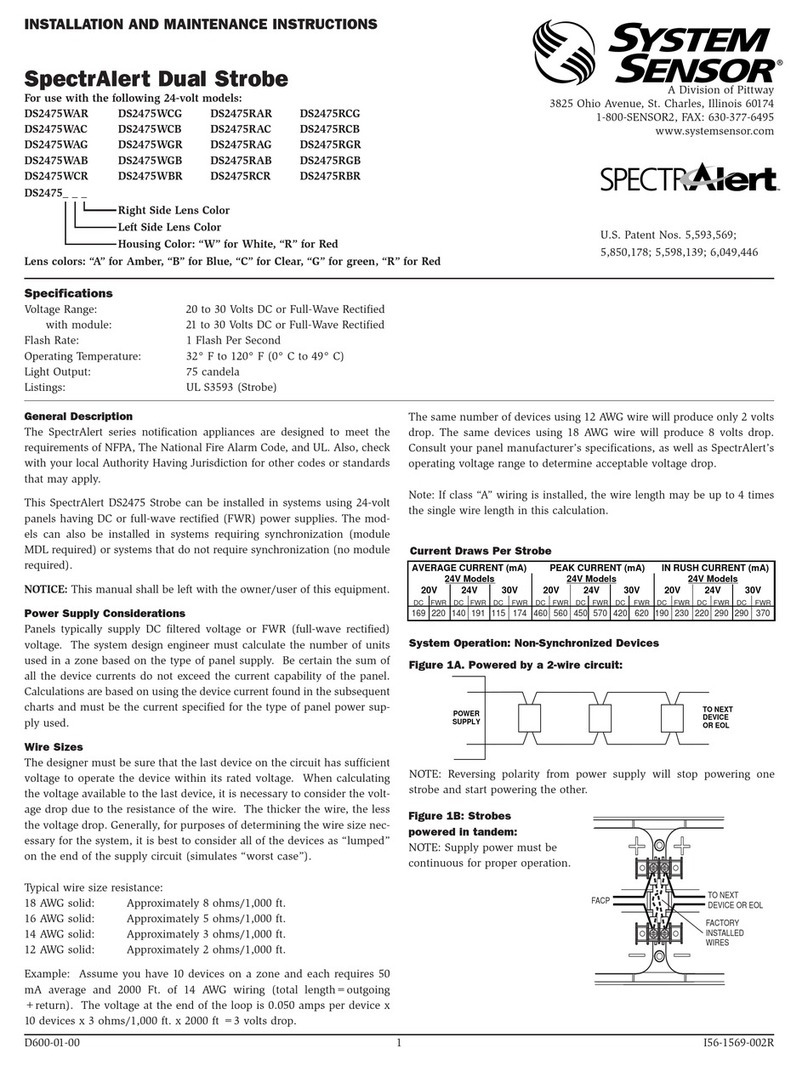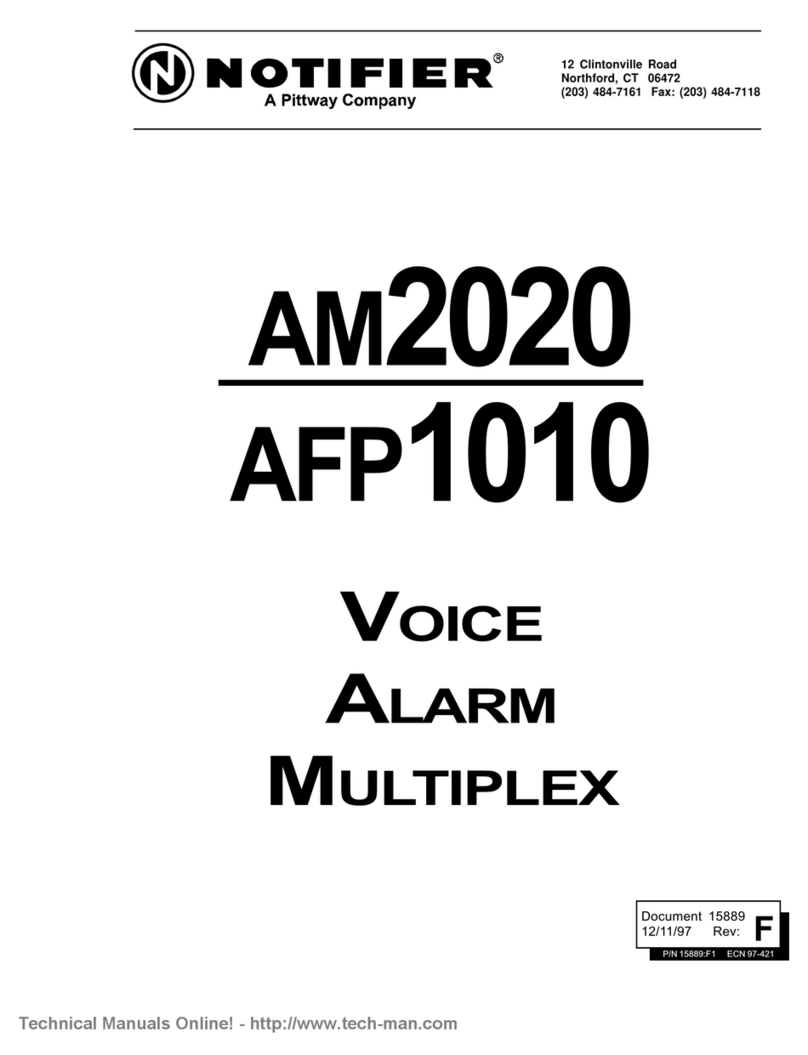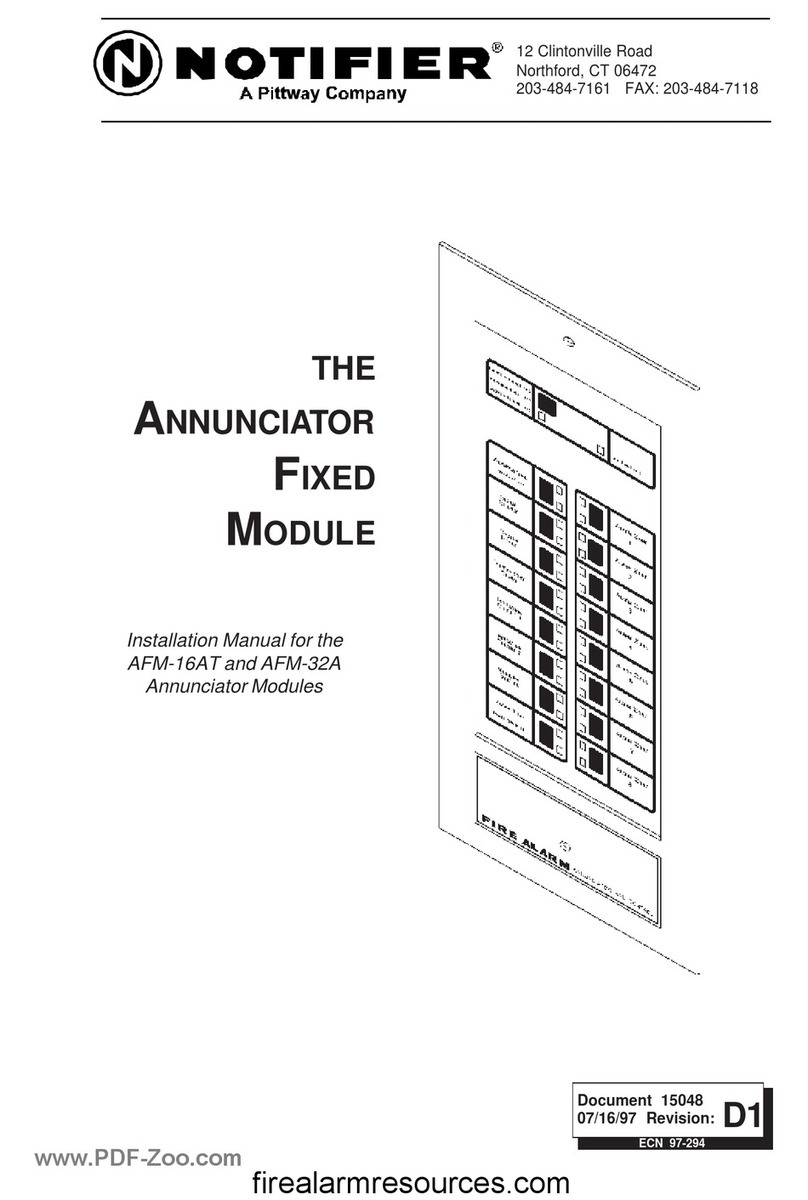D900-13-00 1 I56-0982-100R
SpectrAlert Horns, Strobes, and
Horn/Strobes
For use with the following models:
Horns: 12/24 volt: H12/24
Strobes: 12 volt: S1215, S121575
24 volt: S2415, S2430, S241575, S2475, S24110
Combo: 12 volt: P1215, P121575
24 volt: P2415, P2430, P241575, P2475, P24110
Add suffix “K”for weatherproof horn and horn/strobe, red housing only.
Add suffix “K”for outdoor strobe only, red housing only.
Add suffix “F”for units marked FUEGO, “EV”for EVAC, or “AG”for AGENT, available on 241575, red housing only.
Add suffix “P”for plain (non-printed) 241575 only.
Add suffix “RLP”for Red Lens, “ALP”for Amber Lens, “GLP”for Green Lens, or “BLP”for Blue Lens. Available on 2475 plain, red housing only.
Add suffix “W”for white housing models.
The Products to which this manual applies may be covered by one or more of the following U.S. Patent numbers:
5,914,665; 5,850,178; 5,598,139; 6,049,446; 5,593,569
INSTALLATION AND MAINTENANCE INSTRUCTIONS
A Division of Pittway
3825 Ohio Avenue, St. Charles, Illinois 60174
1-800-SENSOR2, FAX: 630-377-6495
www.systemsensor.com
General Description
The SpectrAlert series notification appliances are designed to meet the
requirements of most agencies governing these devices, including: NFPA,
ADA, The National Fire Alarm Code, UL, FM, CSFM, MEA. Also, check
with your local Authority Having Jurisdiction for other codes or standards
that may apply.
The SpectrAlert series can be installed in systems using 12- or 24-volt pan-
els having DC or full-wave rectified (FWR) power supplies. The series can
also be installed in systems requiring synchronization (module MDL
required) or systems that do not require synchronization (no module
required).
NOTICE: This manual shall be left with the owner/user of this equipment.
Fire Alarm System Considerations
Temporal and Non-Temporal Coded Signals:
The American National Standards Institute and the National Fire Alarm
Code require that all horns used for building evacuation installed after July
1, 1996, must produce Temporal Coded Signals.
Signals other than those used for evacuation purposes do not have to pro-
duce the Temporal Coded Signal. Temporal coding is accomplished by inter-
rupting a steady sound in the following manner:
Power Supply Considerations
Panels typically supply DC filtered voltage or FWR (full-wave rectified)
Specifications
Voltage Range: DC or Full-Wave Rectified
Horn: 10.5 to 30 Volts
Strobes & Horn/Strobes: 12-volt models –10.5 to 17 volts; 24-volt models –20 to 30 volts
(with MDL module): 12-volt models –11 to 17 volts; 24-volt models –21 to 30 volts
NOTE: Horn and combo units will operate on walk tests with on-time durations of 1 sec. or greater.
Flash Rate: 1 Flash Per Second
Operating Temperature: 32°F to 120°F (0°C to 49°C)
K Series: Horn and horn/strobe models are indoor listed, having a temperature range of 32°F to 150°F (0°C to 66°C) and are
Rainproof per UL50 (NEMA 3R).
Strobe only models have a temperature range of –40°F to 158°F (–40°C to 70°C), and are indoor/outdoor listed per
UL1638 and indoor listed per UL1971. The S24110K is rated 60 candela @ –40°C. S2475K and S241575K are rated 41
candela @ –40°C.
Light Output: Models with 15 only in the model number are listed at 15 candela
Models with 1575 are listed at 15 candela per UL 1971 but will provide 75 candela on axis (straight ahead)
Models with 30, 75 or 110 are rated for that candela.
Models with a red, amber, green or blue lens are listed at 75 candela per UL 1638.
Sound Output: Sound output levels are established at Underwriters Laboratories in their reverberant room. Always use the sound out-
put specified as UL Reverberant Room when comparing products.
Listings: UL, FM, CSFM, MEA. K Series models are UL, CSFM, MEA listed only.
Note: For clear lens models only, as tested by UL (reference revised 1971 STD, sections/paragraphs 27A.1-27A.5 and 48.4), the maximum number of
synchronous strobe lights that can be connected to the MDL synch module is 70. The maximum impedance between the adjacent units is 250 ohms.
voltage. The system design engineer must calculate the number of units
used in a zone based on the type of panel supply. Be certain the sum of all
the device currents do not exceed the current capability of the panel.
Calculations are based on using the device current found in the subsequent
charts and must be the current specified for the type of panel power sup-
ply used.
Wire Sizes
The designer must be sure that the last device on the circuit has sufficient
voltage to operate the device within its rated voltage. When calculating
the voltage available to the last device, it is necessary to consider the volt-
age drop due to the resistance of the wire. The thicker the wire, the less
the voltage drop. Generally, for purposes of determining the wire size nec-
essary for the system, it is best to consider all of the devices as “lumped”
on the end of the supply circuit (simulates “worst case”).
Typical wire size resistance:
18 AWG solid: Approximately 8 ohms/1,000 ft.
16 AWG solid: Approximately 5 ohms/1,000 ft.
14 AWG solid: Approximately 3 ohms/1,000 ft.
12 AWG solid: Approximately 2 ohms/1,000 ft.
Example: Assume you have 10 devices on a zone and each requires 50 mA
average and 2000 Ft. of 14 AWG wiring (total length=outgoing +return).
The voltage at the end of the loop is 0.050 amps per device x 10 devices
x 3 ohms/1,000 ft. x 2000 ft =3 volts drop.
Note: If class “A”wiring is installed, the wire length may be up to 4 times
the single wire length in this calculation.
